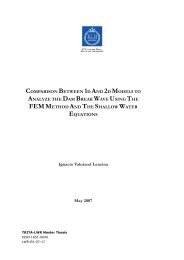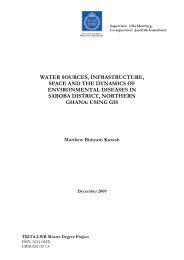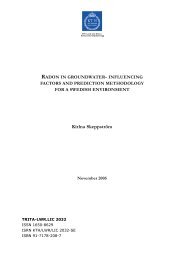POTENTIAL BIOGAS PRODUCTION FROM FISH WASTE AND ...
POTENTIAL BIOGAS PRODUCTION FROM FISH WASTE AND ...
POTENTIAL BIOGAS PRODUCTION FROM FISH WASTE AND ...
You also want an ePaper? Increase the reach of your titles
YUMPU automatically turns print PDFs into web optimized ePapers that Google loves.
Potential Biogas Production from Fish Waste and Sludgetemperature. The condition in each reactor is free oxygen established bythe rubber stoppers sealing the bottle. The produced biogas from thereactor could flow into the Unit B through the connected tube. TheUnit B consists of 15 vials filled with NaOH solution, which are used tofix CO 2 and H 2S based on the acid-base neutralization. Therefore, thepure CH 4 passes through the vial and goes into the Unit C from theconnected tube. The Unit C is the measuring device of gas volume. Theprinciple of its work is liquid displacement. As the defined volume ofCH 4 is accumulated, the flow cell will lift up so that the bubble of gaswill be emerged in the water. Then the flow cell will click back down inthe form of a digital pulse, which is recorded in the computer program.Eventually, the data is collected, analyzed and displayed automatically bythe pre-set program. When the computer is connected with AMPTS IIand linked with the specific internet, the result will be shown directly onthe computer’s interface such as the chart of accumulated CH 4production and the chart of the flow rate of CH 4 yield. All theprocedures are controlled by the connected computer like the conditionof the experiment.Other auxiliary instruments were also needed to support the experimentworking smoothly. Two weighing devices were used to measure the weight of object, i.e.less than 200 g and more than 200 g (Fig. 11). The pH meter 330i was used to measure the pH value of each bottlebefore and after the experiment (Fig. 11). Two ovens were heated in different temperature, i.e. 105 ºC and550 ºC, to obtain dry matter represented by TS content and burnedmatter represented by VS content, respectively (Fig. 11). Theoperation procedure was completely following the Standard Methods(APHA, 1998).3.2. Experimental designIn this project, the solution of enhancing biogas yield would proceedfrom adjusting the proportion of substrates based on previous studiesand real condition.Fig. 9 The NaOHsolution in 3 mol/L.15
















